Psychological warfare, chemical weapons, or the death whistle are the terrifying weapons and tactics used in ancient wars.
The formidable weapons and tactics of ancient warfare
Death whistle of the Aztecs

Several decades ago, archaeologists found burials of strange human heads in an Aztec temple in Mexico. Assuming they are just toys or decorations, they list them and store them in the warehouse. However, a few years later, they discovered that they were deadly whistles that emitted a shrill sound like screaming. The ancient Aztecs used them in sacrifices or to fight to intimidate their enemies.
In battles, the frightening sounds of hundreds of deadly whistles combined have a huge psychological impact, causing the enemy to lose direction and discourage them. It’s like “the sound of people screaming in pain, the wind howling or the screams of thousands of zombies”.
Iron cavalry
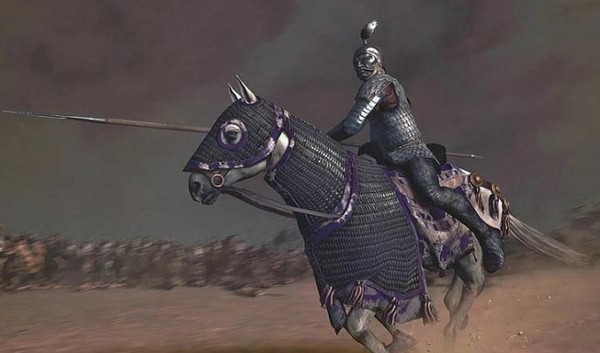
In the 7-8 century BC, tanks were gradually replaced by cavalry units in the Near East. Some units are lightly armed and tasked with harassing the enemy or pursuing enemy troops on the march. Others are heavily equipped, with an ambush mission to break up enemy formation.
The most heavily armed cavalry unit in antiquity was the cataphract. The word “cataphract” comes from the Greek word, meaning “fully armored” or “sealed on all sides”. However, the cataphract is not a Greek product. It is used to refer to the army of the Seleucid Empire around the 4th century BC, after launching several military campaigns against its eastern neighbors.
Usually, the cataphract cavalry was maneuvered when it needed to attack enemy frontlines en masse. Thanks to the heavy armor, the cataphract cavalry can deal a powerful blow to the enemy. Speaking of the strength of the cataphractic cavalry, historian Tacitus wrote that “when they attack the enemy on horseback, almost no front line can stop them”.
The unmatched power of the cataphract can also have a psychological effect on the enemy, historian Cassius Dio said. Describing Crassus’ defeat at the Battle of Carrhae, Dio writes that “many people died of terror from the first wave of these spear-wielding knights.” The cataphract’s fame became even more glorious when Heliodorus and Plutarch declared that they were so powerful that they could stab them to death with one blow.
Toxic
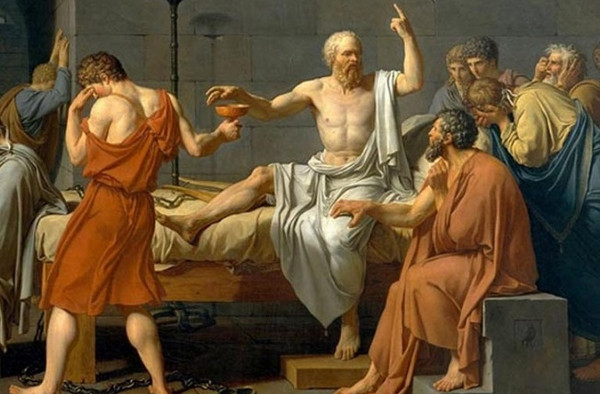
Humans have long used poison as a weapon. In ancient times, people put poison on hunting weapons to quickly kill enemies or prey. When people understand the forces of poison, people create many tools and weapons especially for them. Researchers say more sophisticated and mysterious killing tools are likely reserved for high-ranking members of the tribe, making it easier for outsiders to believe their deaths were caused by force. caused mysticism.
These sudden deaths are often so mysterious and confusing that in some cultures people attribute these poisons to evil spirits, demons, and creatures from the afterlife.
The first poisoned weapon to appear in ancient Greek mythology revolved around Hercules poisoning the arrow with the poison of the monster Hydra. Homer’s epics also refer to the use of poisonous weapons in battle to become a Trojan horse.
The ancients used countless different ways to destroy enemies with poison. For example, the Hindus poison the enemy’s food, the Chinese burn poisonous plants to create what is called “the mist chases the soul”, or the Greeks release the poisoned urge to travel. to the critical aqueducts to poison the water. Even Leonardo da Vinci mentioned a story about a large ship filled with a mixture of sulfur, arsenic and copper rust to attack the enemy ship. On inhaling the vapor of this mixture, the sailors immediately suffocated.
Tank

War chariots were the preeminent weapon in the New Kingdom period of ancient Egypt (16th-11th century BC). In fact, it is considered a super weapon of the ancient world. The history of the chariot begins more than a millennium before its appearance in ancient Egypt.
In 1927-1928, while excavating the area of the Royal Cemetery of Ur in present-day Iraq, British archaeologist Leonard Woolley found an artifact known as the Royal Flag of Ur (dating from the sky). third century BC). One side of this artifact depicts the Mesopotamian war machine shaped like a four-wheel rickshaw pulled by four donkeys. The artist also explained how to use this weapon with drawings illustrating its different states of movement. These donkeys walk first, then trot and finally gallop. So that viewers understand that this is a combat weapon, the artist also adds a drawing of one or two enemies crushed by a tank.
The ancient Egyptians used tanks primarily to protect infantry. Because the topography of Egypt and Canaan was not suitable for the deployment of heavy tanks, the Egyptians used tanks as mobile firing platforms instead of using them to directly attack the enemy. The warriors on the chariot are equipped with bows, arrows and short spears. Not only did they use tanks to shoot arrows like rain at the enemy, the Egyptians also used this war machine to drive out fleeing enemies.
Greek fire

The “Greek fire” or “sea fire” is the weapon that first appeared in the Byzantine Empire in the 7th century. According to historian Theophanes, it was invented in the 6th century by Greek architect Kallinikos, was a resident of the city of Heliopolis before moving to Baalbeck. It is still controversial. Some other historians claim that it was invented in Constantinople by a group of Alexandrian chemists.
This weapon is a liquid. People pour it into pots, then throw stones at enemy ships or spray with a hose. He ignited himself. It is worth noting that the fire still burns in the water and pouring water into the fire only makes it even more widespread. Therefore, it is very difficult to control the fire. A single negligence could inflict great damage and loss to Byzantine ships.
This weapon largely contributed to the victory of Constantinople against the Arab army and many other invading armies.
Biological weapons

History records the dreadful effects that disease, pollution and toxins can have on humans. Since prehistoric times people have learned a lot of experience and knowledge from these expensive lessons and have used them extensively in creating biological weapons and using them constantly. in the fight against the enemy.
In ancient times, people did not fully understand the spread of disease, but believed that corpses or rotting animals were the source of the disease. Since 400 BC, Scythian archers have been known to immerse their names in corpses and blood stained with excrement. British archers often stuck the tip of an arrow into the ground just in front of them. In doing so, not only will they be able to draw the arrow and shoot it quickly, but the tip of the arrow will become dirty and easily infect the person hit by the arrow. Since 300 BC, Greek, Roman and Persian warriors have polluted wells with excrement and dead animals.
In the 14th century, the Black Death, a pandemic considered to be a plague epidemic that spread across Europe, the Near East and North Africa, caused the largest medical disaster in human history and took it away. lives from 75 to 200 million people. It is painful to know that this pandemic is partly caused by people during the war. The corpse was thrown over the walls of the besieged city to intimidate, creating an unbearable stench (the smell itself contained germs) and infecting the enemy.
Scythian flyback tactics
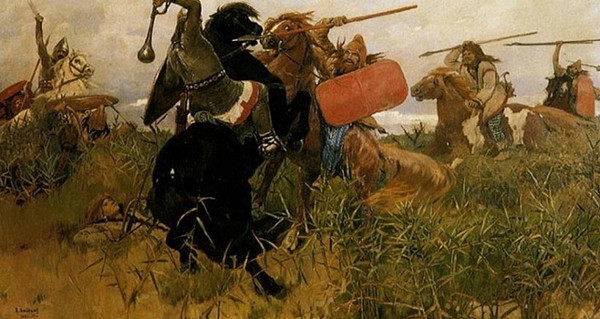
The Scythians are famous for the fly tactic, which is practiced before engaging in any other tactics such as diversion or defense.
When using this tactic, multiple units surround and attack the target at the same time. However, units will move with the same target in order to consume every part of the enemy’s life force and disrupt enemy formation directly from within. The slow movement and constant shooting from afar made the enemy terrified and disheartened. The Roman army must have tasted this as they could only move and fight during an enemy siege just three feet away. The Scythians took advantage of this loophole at the Battle of Carrhae in 53 BC.
“They (the Romans) were clustered together in a tight space, entangled and cast down by name,” wrote Greek historian Plutarch.
The dense arrow fence gradually caused the enemy to lose direction, so that the archers on horseback could absolutely focus on destroying the enemy. Arguably the opening tactics of this battle meant shooting arrows like rain at the enemy, holding the target firmly to drain the enemy’s life force, allowing the mounted archers to shoot howling and aim. precisely. target.
Chemical Weapons
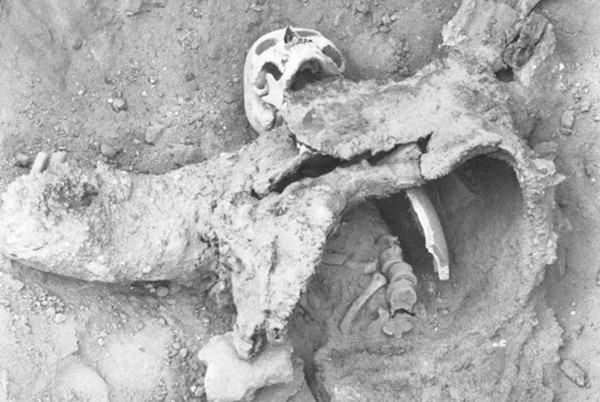
The earliest archaeological evidence for the use of chemical weapons can be found in the Dura-Europos region on the banks of the Euphrates River in Syria. Dura-Europos is a Roman city that fell into the hands of the Sassans around the middle of the 3rd century.
Although there is no record of the last siege, French and American archaeologists have found clues as to what happened. Numerous excavations of the town of Dura-Europos were carried out in the 1920s and 1930s. Archaeologists found a Persian mine and another Roman mine. In addition, they found the bodies of at least 19 Roman soldiers and one Sassania soldier crammed into the tunnel.
In 2009, after studying the evidence gathered, we understood what had happened during the siege. The Sassans used poison gas to destroy the Roman guards. They threw sulfur and tar into the fire, forming asphyxiating gas. When the Roman guards have inhaled, the gas turns into sulfuric acid. A few minutes later, the Romans in the tunnel were all dead. This happened when the Romans broke into the Sassanid mines located just below their mines. The only Sassania soldier who died could have been the victim of the same weapon he was carrying and also died of suffocation from poison gas. Once the tunnel was cleared, the Sassans piled the corpses of soldiers into a pile in the mouth of the Roman pit as a protective wall and entered to destroy the tunnel.
The Battle of Pelusium is an important and historic battle that took place in the 6th century BC. In this battle, the Persians defeated the Egyptians and became the new owners of this land. Battle is one of the earliest examples of the use of psychological warfare. Knowing that the Egyptians worshiped cats and considered them a symbol of the goddess Bastet, the Persian king Cambyses II ordered his soldiers to draw a picture of a cat on their shield. It is said that during the match the Persian army was always behind a large herd of cats. The Egyptians did not dare to harm this sacred animal, so they were forced to offer it to the Persians.
Archimedes’ heat ray weapon
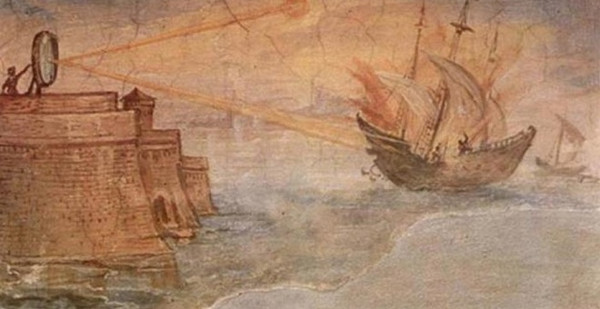
The Greek mathematician, engineer, inventor and astronomer Archimedes (287-212 BC) is said to have invented a thermal ray weapon, also known as a “death ray” to dispel Destroy ships war that attacked Syracuse, a famous city in Sicily’s history. According to author Lucian in the second century and centuries later, this weapon focuses light reflected from polished copper shields on enemy ships, causing them to ignite.
Although historians still debate this weapon, experiments that have shown its existence are possible. In 1973, Greek scientist Ioannis Sakkas erected 70 bronze-coated mirrors on a model of the plywood Roman warship at a distance of 50 meters. When the light reflected from the mirrors focused on the ship, it caught fire.
In 2005, a group of students from the Massachusetts Institute of Technology also successfully simulated this ancient weapon. They used square mirrors to burn a ship in San Francisco harbor.


